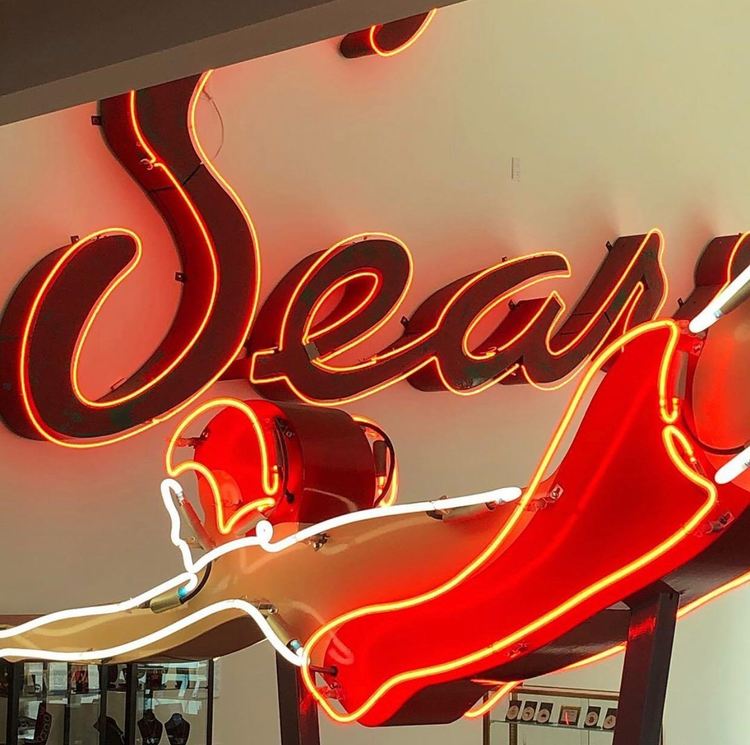
The Art, Craft, and Science of Neon
Neon holds a peculiar place at the intersection of art, science, commerce, sleaze and genius. The characteristic “glow” associated with neon comes directly from the captive electrons themselves. Skilled craftspeople pump an inert (so-called “noble”) gas—like neon itself—into a glass vacuum tube with electrodes on either end, and apply high voltage. The electricity excites electrons in the neon molecules, causing them to emit photons—light—in characteristic colors. Each noble gas glows in its own
hue: neon is red-orange, while argon is pale purple (or steely blue with the addition of a drop of mercury).
Neon artists and craftspeople can use different colors of glass tubing, or glass tubing coated with phosphors— which themselves glow when electrified—to produce light in virtually any imaginable color.
Developed from nineteenth-century electrical experimentations in Europe and the U.S., the first of what we know as neon signs emerged just before World War I in France, and in the 1920s in the U.S. Soon,
due to neon’s spectacular flexibility of form and color, commercial neon signs began to replace the existing technology of light-bulb-lit signs. By the late 1920s, neon became the predominant form of sign illumination—cities across the U.S. glowed with the rainbow colors of neon.
Neon signs represented a modern form of illumination—forward looking for the speed-age of the 1920s, and the streamlined era of the 1930s. Drawing customers and distinguishing places of business, neon signs became more elaborate, more colorful, and even brighter.
In the U.S., neon flourished synergistically with the automobile. Roadside businesses like restaurants and motels drew customers from dark highways with spectacular flashing neon, creating a distinctive American landscape in cities and towns, but also along the very roads themselves, as highways like
Route 66 became neon arterials.
But WWII brought blackouts and materials restrictions—signs across the U.S. fell dark. In the Post- War era a new prosperity demanded new technology—plastic faces now hid the neon tubing. Exposed neon took on a different image—the flashing hotel sign that once marked distinction, now illuminated a hard-luck flop house, and signs advertising “bar” or even “XXX” drew a particular clientele, until neon became associated with all that was tawdry about the night, typified by Jack Kerouac’s “red brick and
neon” skid rows, and the dark imagery of film noir.
In the mid-twentieth century neon was challenged by fluorescent lighting, and then in the late-twentieth century by LED lighting—both sources of illumination demanding little artistic or artisanal ability. Still, neon artists and craftspeople maintained their craft.
And, just as neon fell from grace, artists began to experiment with the medium, crafting works of kinetic and electric art from luminous tubing. By the 1970s, neon art became an established form, helping
to rekindle an interest in neon signs as well.
Today, neon remains a sought-after art form used in selective applications of art and commerce. The craft of neon remains essentially unchanged after some one hundred years—artisans use the same tools and techniques as their forebears, and, just as in the early twentieth century, each neon sign is hand made, a work of science, art, and hand-craft skill.
The Museum of Neon Art was founded by artists in 1981 in order to preserve historic neon signs, stimulate artistic uses of neon, and to build public awareness of the science, art, and craft of neon.
Dydia DeLyser & Paul Greenstein Copyright © 2016 Museum of Neon Art
-
Welcome to Fort Settlement Middle School- Principals Welcome Message
-
Parking, Drop Off, and Dismissal Procedures
-
Lockers
-
Staying Connected!
-
Cell Phone and Laptop Use at FSMS
-
Welcome to the Cafeteria at The Fort!
-
The FSMS Library
-
The Clinic at The Fort
-
The Attendance Office: What To Do When You Are Absent
-
Dress Code Reminders for FBISD
-
The Counselors Office